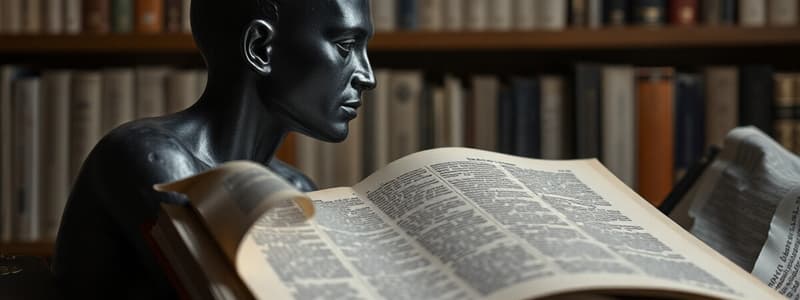Podcast
Questions and Answers
Which literary approach focuses on the portrayal of social realities and class struggles?
Which literary approach focuses on the portrayal of social realities and class struggles?
- Psychological Approach
- Feminist Approach
- Marxist Approach (correct)
- Formalist Approach
What does contemporary literature generally refer to?
What does contemporary literature generally refer to?
- Literature written before 1945
- Works published after 1945 (correct)
- All historical literature
- Only poetry written in the modern era
Which literary approach aims to understand gender inequality and its societal roots?
Which literary approach aims to understand gender inequality and its societal roots?
- Historicism
- Structuralist Approach
- Feminist Approach (correct)
- Psychological Approach
Which is NOT a characteristic feature of Modernism in literature?
Which is NOT a characteristic feature of Modernism in literature?
What distinguishes the Formalist approach in literature?
What distinguishes the Formalist approach in literature?
Which of the following is an example of a work studied through the Psychological Approach?
Which of the following is an example of a work studied through the Psychological Approach?
What major theme is often explored in Contemporary literature?
What major theme is often explored in Contemporary literature?
Which concept is central to the definition of Contemporary literature?
Which concept is central to the definition of Contemporary literature?
What does biographical criticism primarily focus on to understand literary texts?
What does biographical criticism primarily focus on to understand literary texts?
Which type of criticism considers the social and political environment where a work was composed?
Which type of criticism considers the social and political environment where a work was composed?
Which of the following is an example of onomatopoeia?
Which of the following is an example of onomatopoeia?
What does the term 'symbolism' refer to in literature?
What does the term 'symbolism' refer to in literature?
Which figure of speech directly compares two unrelated things without using 'like' or 'as'?
Which figure of speech directly compares two unrelated things without using 'like' or 'as'?
What is the main purpose of using alliteration in literature?
What is the main purpose of using alliteration in literature?
What does an oxymoron consist of?
What does an oxymoron consist of?
Which of the following best describes assonance?
Which of the following best describes assonance?
Flashcards are hidden until you start studying
Study Notes
Literature Overview
- Literature encompasses various forms of written expression including poetry, novels, history, biography, and essays that reflect ideas of permanent and universal interest.
Modern Approaches in the Study of Literature
-
Psychological Approach
- Utilizes psychological theories to analyze literary works to deepen understanding.
- Example: "When I Have Fears That I May Cease to Be" by John Keats.
-
Feminist Approach
- Investigates gender inequality and its foundations.
- Key conflict theory in sociology, addressing ongoing societal conflicts between genders.
- Example: "Emancipation: A Life Fable" by Kate Chopin.
-
Marxist Approach
- Focuses on social and economic influences on literature.
- Analyzes class struggles and social realities in texts.
- Example: "Romeo and Juliet" by William Shakespeare.
Contemporary Literature
- Refers to works published since 1945, emphasizing the authors' experiences and emotions in real-world contexts.
- Characterized by diverse writing styles and emphasis on realistic characters.
- Associated with postmodernism, an evolution of modern literary movements that began in the early 1900s.
Modern vs. Contemporary Literature
-
Modern Literature
- Spanning from approximately 1900 to the early 1940s, characterized by experimentation and new forms.
-
Contemporary Literature
- Encompasses prose, poetry, and drama published from 1945 to present.
Contemporary Approaches in Literature
-
Formalism
- Examines literary elements such as symbol, imagery, and structure.
- Prioritizes language arrangement over historical or biographical context.
- Example: Shakespearean sonnets dictate structure and theme.
-
Biographical Criticism
- Links an author's life and experiences to their literary works.
- Argues that understanding an author’s background is essential for text comprehension.
-
Historical Criticism
- Investigates the historical and social contexts in which a work was created.
- Considers societal events or movements impacting the author's perspective and writing.
Figurative Language
-
Sound Devices
- Alliteration: Repetition of consonant sounds (e.g., "She sells seashells by the seashore").
- Consonance: Repetition of consonant sounds within phrases (e.g., "Mike likes his new bike").
- Assonance: Repetition of vowel sounds (e.g., "The rain in Spain stays mainly in the plain").
- Onomatopoeia: Words that mimic natural sounds (e.g., "The bees buzzed in the garden").
-
Symbolism
- Symbols convey meanings beyond their literal interpretations.
- Common symbols: Dove for peace, dog for loyalty, black for war, red for love or death.
Figures of Speech
-
Simile
- Compares two different things using "like" or "as" (e.g., "Her voice is like a melody").
-
Metaphor
- Describes one thing by referring to another, suggesting a comparison (e.g., "Time is a thief").
-
Antithesis
- Juxtaposes opposing ideas for contrast (e.g., "Speech is silver, but silence is gold").
-
Oxymoron
- Combines contradictory terms (e.g., "Bitter sweet").
Studying That Suits You
Use AI to generate personalized quizzes and flashcards to suit your learning preferences.




